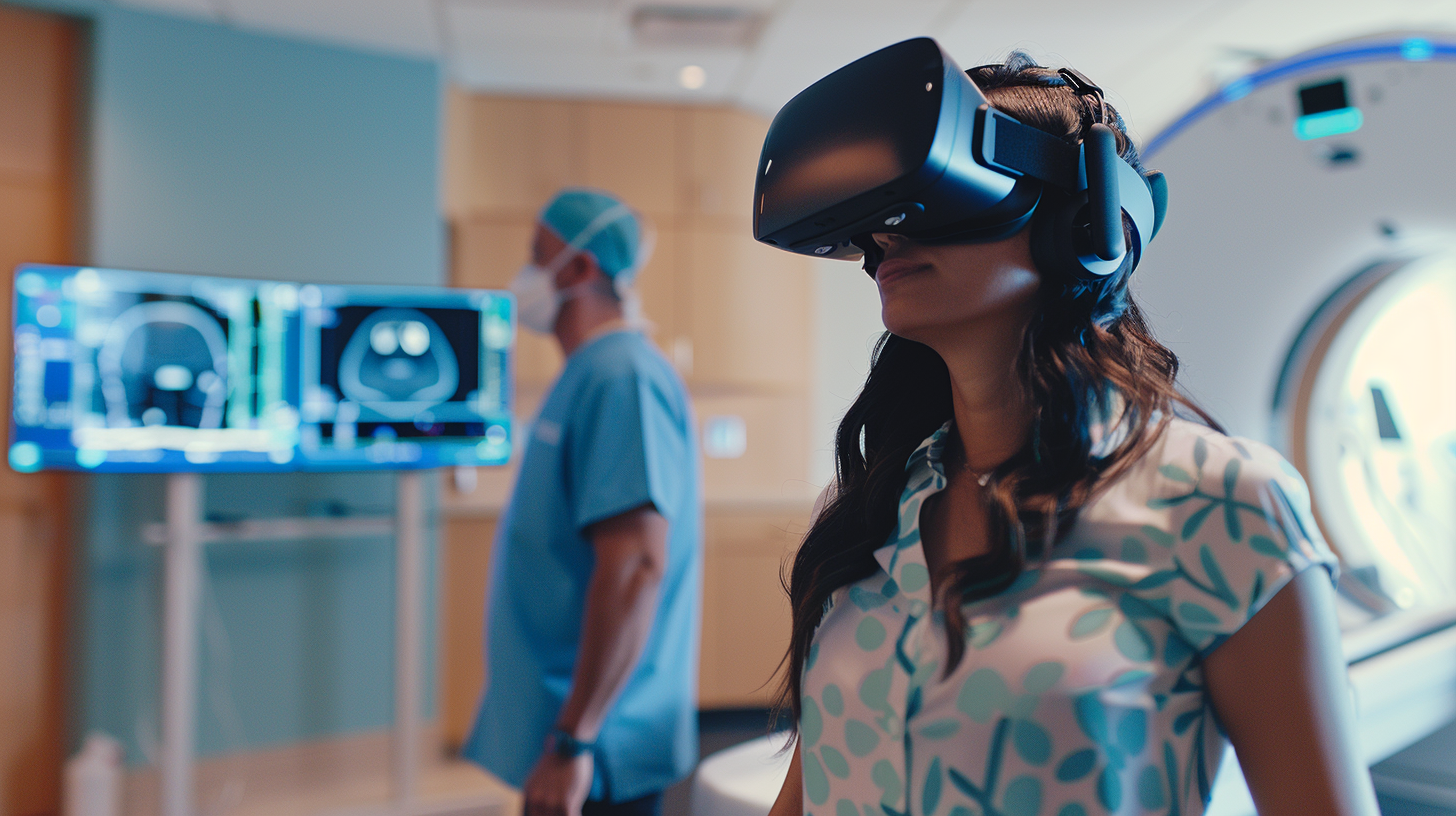Virtual reality (VR) has rapidly gained popularity and is transforming various industries, including healthcare. As technology continues to evolve, healthcare providers are exploring innovative ways to improve patient engagement and enhance overall patient experience. VR is emerging as a powerful tool in achieving these goals. By creating immersive and interactive experiences, VR has the potential to revolutionize the way patients interact with healthcare providers and facilities.
The Rise of Virtual Reality in Healthcare
In recent years, VR technology has made remarkable strides, with advancements in graphics, hardware, and software capabilities. These advancements have paved the way for VR to be integrated into healthcare settings, offering a range of benefits for both patients and providers. Healthcare professionals are increasingly recognizing the potential of VR in patient engagement, from reducing anxiety and pain during medical procedures to enhancing the overall patient experience.
One of the key areas where virtual reality is making a significant impact in healthcare is in medical training and education. VR simulations allow medical students and professionals to practice surgical procedures in a realistic and risk-free environment. This hands-on training can help improve surgical skills, decision-making abilities, and overall confidence in healthcare providers, ultimately leading to better patient outcomes.
Furthermore, virtual reality is also being used in cognitive rehabilitation therapy for patients with neurological conditions such as stroke or traumatic brain injury. By immersing patients in interactive environments, VR therapy can help improve cognitive functions such as memory, attention, and problem-solving skills. This innovative approach to rehabilitation not only enhances patient engagement and motivation but also provides healthcare providers with valuable data to track progress and tailor treatment plans accordingly.
How Virtual Reality Enhances Patient Experience
Virtual reality has the ability to transport patients to alternate environments, providing a welcome distraction from the clinical setting. For instance, VR can transport pediatric patients to colorful and vibrant virtual worlds while undergoing medical procedures, making the experience less daunting and more engaging. Similarly, VR can offer relaxation experiences to patients undergoing chemotherapy or other long and arduous treatments, providing a much-needed escape from the monotony of the hospital environment.
Moreover, VR can serve as an educational tool, allowing patients to visualize and better understand their medical conditions. By immersing patients in virtual simulations, healthcare providers can educate them about their conditions, treatment options, and potential outcomes. This not only empowers patients to make informed decisions about their healthcare but also enhances their overall engagement in their own care.
Virtual reality technology continues to evolve, offering new possibilities for enhancing patient experiences. One innovative application involves using VR to reduce pain perception during medical procedures. By immersing patients in immersive virtual environments, their focus shifts away from the physical discomfort, leading to a decrease in perceived pain levels. This approach not only improves the patient's experience during the procedure but also has the potential to reduce the need for additional pain management interventions.
Furthermore, VR simulations can be tailored to individual patient preferences, creating personalized experiences that cater to their unique needs. Whether a patient finds solace in serene natural landscapes or prefers engaging in interactive games to distract themselves, VR can be customized to provide the most beneficial and enjoyable experience for each individual. This level of personalization not only enhances the therapeutic benefits of virtual reality but also fosters a sense of control and autonomy for patients in healthcare settings.
Benefits of Virtual Reality for Outpatient Imaging Centers
Outpatient imaging centers often serve patients who may experience anxiety and discomfort during diagnostic procedures. By leveraging VR technology, these centers can significantly improve the patient experience. For instance, VR headsets can be used to create a relaxing and immersive environment during MRI or CT scans, distracting patients from the noise and claustrophobia typically associated with these procedures.
In addition, VR can help alleviate the fear and anxiety that often accompanies radiology procedures, especially for children. Through virtual simulations, patients can explore an MRI machine before the actual scan, reducing fear and uncertainty. This technology not only enhances patient comfort but can also lead to more successful scans by minimizing patient movement and improving image quality.
Furthermore, virtual reality can be a valuable tool for patient education in outpatient imaging centers. By using VR technology, healthcare providers can visually demonstrate the imaging process to patients, helping them understand what to expect during their procedure. This visual aid can empower patients with knowledge, reducing their anxiety and increasing their cooperation during the scan.
Moreover, VR can be utilized for pain management in outpatient imaging centers. Studies have shown that immersive VR experiences can help distract patients from discomfort or pain, making the imaging process more tolerable for individuals undergoing procedures such as biopsies or injections. By incorporating VR into pain management strategies, outpatient imaging centers can enhance the overall patient experience and improve outcomes.
Implementing Virtual Reality in Patient Engagement Strategies
As healthcare organizations recognize the potential of VR in patient engagement, they must carefully plan and implement VR programs to maximize their impact. One of the key considerations is ensuring accessibility for all patients. VR experiences should be tailored to accommodate patients with physical disabilities, visual impairments, or cognitive limitations.
Furthermore, healthcare providers need to invest in the necessary resources and technology to support VR implementation. This includes VR headsets, software platforms, and trained staff who can guide patients through their VR experiences. Additionally, data privacy and security must be prioritized to protect patient information during VR sessions.
Moreover, integrating VR into patient engagement strategies can revolutionize the way healthcare is delivered. By immersing patients in virtual environments, healthcare providers can create interactive educational experiences that enhance patient understanding of complex medical procedures and conditions. For example, virtual simulations can allow patients to explore the human body in 3D, providing a deeper insight into their own health and treatment options.
Another benefit of VR in patient engagement is its ability to reduce anxiety and pain during medical procedures. Studies have shown that VR distraction therapy can significantly lower patients' perception of pain and discomfort, making it a valuable tool in managing chronic pain or undergoing invasive treatments. Healthcare organizations can leverage VR technology to improve patient comfort and overall satisfaction with their care.
Challenges and Considerations in Adopting Virtual Reality
While the potential benefits of VR in patient engagement are vast, there are also challenges and considerations that healthcare organizations must address. One challenge is the cost associated with implementing VR programs. The initial investment in hardware and software can be significant, and ongoing maintenance and updates may be required.
Healthcare providers must also consider the potential risks and side effects of VR. For instance, motion sickness and discomfort can occur in some individuals during VR experiences. It is crucial to provide patients with appropriate guidance and support to minimize these issues and ensure a positive experience.
Another important consideration is the need for specialized training for healthcare staff to effectively utilize VR technology. Proper training ensures that healthcare professionals can confidently navigate VR applications and provide optimal care to patients using this innovative technology.
Furthermore, data security and patient privacy are significant concerns when implementing VR in healthcare settings. Healthcare organizations must implement robust security measures to protect sensitive patient information and ensure compliance with data protection regulations.
Future Trends and Innovations in Virtual Reality for Patient Engagement
The future of VR in patient engagement looks promising, with ongoing advancements and innovations. As technology continues to evolve, VR experiences are expected to become even more immersive and realistic. Improved haptic feedback, enhanced visual quality, and increased interactivity will further enhance patient engagement and make VR an integral part of healthcare delivery.
Moreover, the integration of artificial intelligence (AI) with VR holds great potential. AI algorithms can adapt VR experiences based on individual patient preferences, medical conditions, and responses, further personalizing the patient's virtual environment and improving outcomes.
One exciting development on the horizon is the use of VR in pain management. Studies have shown that immersive VR experiences can help distract patients from pain, reducing the need for traditional pain medications. By creating captivating virtual worlds that patients can explore, healthcare providers can offer a non-pharmacological approach to pain relief.
Furthermore, the application of VR in mental health therapy is gaining traction. Therapists are exploring the use of VR environments to treat phobias, anxiety disorders, and PTSD. By exposing patients to controlled virtual scenarios that trigger their symptoms, therapists can guide them through exposure therapy in a safe and supportive setting, potentially accelerating the healing process.
Conclusion
In conclusion, virtual reality is poised to revolutionize patient engagement in healthcare. With its ability to create immersive, interactive, and personalized experiences, VR holds tremendous potential in improving patient experiences, reducing anxiety and pain, and enhancing patient education. As healthcare providers embrace this technology, they must carefully consider implementation strategies, address potential challenges, and stay abreast of future trends and innovations. Virtual reality has the potential to be the next big thing in patient engagement, transforming the way healthcare is delivered and experienced.
As we look towards the future of patient engagement, embracing cutting-edge technologies like virtual reality can set your radiology practice apart. AbbaDox, with its cloud-based platform designed to optimize radiology workflows, provides the perfect foundation to integrate VR into your patient care strategy. Unify your imaging center operations and enhance patient experiences with our scalable and flexible solutions. Meet with a product consultant today to discover how AbbaDox can transform your practice and keep you at the forefront of healthcare innovation.







